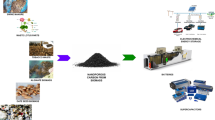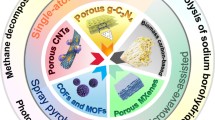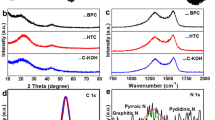Abstract
The massive conversion of resourceful biomass to carbon nanomaterials not only opens a new avenue to effective and economical disposal of biomass, but provides a possibility to produce highly valued functionalized carbon-based electrodes for energy storage and conversion systems. In this work, biomass is applied to a facile and scalable one-step pyrolysis method to prepare three-dimensional (3D) carbon nanotubes/mesoporous carbon architecture, which uses transition metal inorganic salts and melamine as initial precursors. The role of each employed component is investigated, and the electrochemical performance of the attained product is explored. Each component and precise regulation of their dosage is proven to be the key to successful conversion of biomass to the desired carbon nanomaterials. Owing to the unique 3D architecture and integration of individual merits of carbon nanotubes and mesoporous carbon, the assynthesized carbon nanotubes/mesoporous carbon hybrid exhibits versatile application toward lithium-ion batteries and Zn-air batteries. Apparently, a significant guidance on effective conversion of biomass to functionalized carbon nanomaterials can be shown by this work.

Similar content being viewed by others
References
Titirici M, White J, Brun N, Budarin L, Su S, del Monte F, MacLachlan J. Sustainable carbon materials. Chemical Society Reviews, 2015, 44(1): 250–290
Liu X, Dai L. Carbon-based metal-free catalysts. Nature Reviews Materials, 2016, 1(11): 16064
Yan J, Wang Q, Wei T, Fan Z. Recent advances in design and fabrication of electrochemical supercapacitors with high energy densities. Advanced Energy Materials, 2014, 4(4): 1300816
Zhang Q, Cheng X, Huang J, Peng H, Wei F. Review of carbon materials for advanced lithium-sulfur batteries. Carbon, 2015, 81: 850
Liu H, Liu X, Li W, Guo X, Wang Y, Wang G, Zhao D. Porous carbon composites for next generation rechargeable lithium batteries. Advanced Energy Materials, 2017, 7(24): 1700283
Zheng M, Chi Y, Hu Q, Tang H, Jiang X, Zhang L, Xu Q. Carbon nanotube-based materials for lithium—sulfur batteries. Journal of Materials Chemistry A: Materials for Energy and Sustainability, 2019, 7(29): 17204–17241
Dai L, Chang W, Baek B, Lu W. Carbon nanomaterials for advanced energy conversion and storage. Small, 2012, 8(8): 1130–1166
Kim M, Park T, Wang C, Tang J, Lim H, Hossain M, Konarova M, Yi J, Na J, Kim J, Yamauchi Y. Tailored nanoarchitecturing of microporous ZIF-8 to hierarchically porous double-shell carbons and their intrinsic electrochemical property. ACS Applied Materials & Interfaces, 2020, 12(30): 34065–34073
Kim M, Xu X, Xin R, Earnshaw J, Ashok A, Kim J, Park T, Nanjundan A K, El-Said W A, Yi J, Na J, Yamauchi Y. KOH-activated hollow ZIF-8 derived porous carbon: nanoarchitectured control for upgraded capacitive deionization and supercapacitor. ACS Applied Materials & Interfaces, 2021, 13(44): 52034–52043
Gupta N, Gupta M, Sharma K. Carbon nanotubes: synthesis, properties and engineering applications. Carbon Letters, 2019, 29(5): 419–447
Moothi K, Iyuke S, Meyyappan M, Falcon R. Coal as a carbon source for carbon nanotube synthesis. Carbon, 2012, 50(8): 2679–2690
Hoang V C, Hassan M, Gomes V G. Coal derived carbon nanomaterials recent advances in synthesis and applications. Applied Materials Today, 2018, 12: 342–358
Zhang G, Liu X, Wang L, Fu H. Recent advances of biomass derived carbon-based materials for efficient electrochemical energy devices. Journal of Materials Chemistry A: Materials for Energy and Sustainability, 2022, 10(17): 9277–9307
Zhang S, Jiang F, Huang B C, Shen X C, Chen W J, Zhou T P, Yu H Q. Sustainable production of value-added carbon nanomaterials from biomass pyrolysis. Nature Sustainability, 2020, 3(9): 753–760
Voloshin R A, Rodionova M V, Zharmukhamedov K, Nejat Veziroglu T, Allakhverdiev S I. Review: biofuel production from plant and algal biomass. International Journal of Hydrogen Energy, 2016, 41(39): 17257–17273
Osman A I, Mehta N, Elgarahy A M, Al Hinai A, Al Muhtaseb A H, Rooney D W. Conversion of biomass to biofuels and life cycle assessment: a review. Environmental Chemistry Letters, 2021, 19(6): 4075–4118
Alper K, Tekin K, Karagöz S, Ragauskas A J. Sustainable energy and fuels from biomass: a review focusing on hydrothermal biomass processing. Sustainable Energy & Fuels, 2020, 4(9): 4390–4414
Wang Z, Shen D, Wu C, Gu S. State-of-the-art on the production and application of carbon nanomaterials from biomass. Green Chemistry, 2018, 20(22): 5031–5057
Reina A, Jia X, Ho J, Nezich D, Son H, Bulovic V, Kong J. Large area, few-layer graphene films on arbitrary substrates by chemical vapor deposition. Nano Letters, 2009, 9(1): 30–35
Bi Z, Kong Q, Cao Y, Sun G, Su F, Wei X, Chen M. Biomass-derived porous carbon materials with different dimensions for supercapacitor electrodes: a review. Journal of Materials Chemistry A: Materials for Energy and Sustainability, 2019, 7(27): 16028–16045
Balahmar N, Mitchell A C, Mokaya R. Generalized mechanochemical synthesis of biomass-derived sustainable carbons for high performance CO2 storage. Advanced Energy Materials, 2015, 5(22): 1500867
Wang Y, Zhang M, Shen X, Wang H, Wang H, Xia K, Yin Z, Zhang Y. Biomass-derived carbon materials: controllable preparation and versatile applications. Small, 2021, 17(40): 2008079
Yin J, Zhang W, Alhebshi N, Salah N, Alshareef H. Synthesis strategies of porous carbon for supercapacitor applications. Small Methods, 2020, 4(3): 1900853
Lyu L, Seong K, Ko D, Choi J, Lee C, Hwang T, Cho Y, Jin X, Zhang W, Pang H, Piao Y. Recent development of biomass-derived carbons and composites as electrode materials for supercapacitors. Materials Chemistry Frontiers, 2019, 3(1): 2543–2570
Zhang M, Zhang J, Ran S, Sun W, Zhu Z. Biomass-derived sustainable carbon materials in energy conversion and storage applications: status and opportunities. A mini review. Electrochemistry Communications, 2022, 138: 107283
Yang W, Liu X, Yue X, Jia J, Guo S. Bamboo-like carbon nanotube/Fe3C nanoparticle hybrids and their highly efficient catalysis for oxygen reduction. Journal of the American Chemical Society, 2015, 137(4): 1436–1439
Kang J, Duan X, Wang C, Sun H, Tan X, Tade M O, Wang S. Nitrogen-doped bamboo-like carbon nanotubes with Ni encapsulation for persulfate activation to remove emerging contaminants with excellent catalytic stability. Chemical Engineering Journal, 2018, 332: 398–408
Chen S, Bao P, Wang G. Synthesis of Fe2O3-CNT-graphene hybrid materials with an open three-dimensional nanostructure for high capacity lithium storage. Nano Energy, 2013, 2(3): 425–434
Yan N, Zhou X, Li Y, Wang F, Zhong H, Wang H, Chen Q. Fe2O3 nanoparticles wrapped in multi-walled carbon nanotubes with enhanced lithium storage capability. Scientific Reports, 2013, 3(1): 3392
Zhang B, Li T, Huang L, Ren Y, Sun D, Pang H, Tang Y. In situ immobilization of Fe/Fe3C/Fe2O3 hollow hetero-nanoparticles onto nitrogen-doped carbon nanotubes towards high-efficiency electrocatalytic oxygen reduction. Nanoscale, 2021, 13(10): 5400–5409
Bistamam M S A, Azam M A. Tip-growth of aligned carbon nanotubes on cobalt catalyst supported by alumina using alcohol catalytic chemical vapor deposition. Results in Physics, 2014, 4: 105–106
Gohier A, Ewels C P, Minea T M, Djouadi M A. Carbon nanotube growth mechanism switches from tip- to base-growth with decreasing catalyst particle size. Carbon, 2008, 46(10): 1331–1338
Behan J A, Mates Torres E, Stamatin S N, Domínguez C, Iannaci A, Fleischer K, Colavita P E. Oxygen reduction reaction: untangling cooperative effects of pyridinic and graphitic nitrogen sites at metal-free N-doped carbon electrocatalysts for the oxygen reduction reaction. Small, 2019, 15(48): 1970256
Li J, Zhang Y, Zhang X, Han J, Wang Y, Gu L, Song B. Direct transformation from graphitic C3N4 to nitrogen-doped graphene: an efficient metal-free electrocatalyst for oxygen reduction reaction. ACS Applied Materials & Interfaces, 2015, 7(35): 19626–19634
Yang L, Huang N, Lu C, Yu H, Sun P, Lv X, Sun X. Atomically dispersed and nanoscaled Co species embedded in micro-/mesoporous carbon nanosheet/nanotube architecture with enhanced oxygen reduction and evolution bifunction for Zn-air batteries. Chemical Engineering Journal, 2021, 404: 127112
Biemolt J, Rothenberg G, Yan N. Understanding the roles of amorphous domains and oxygen-containing groups of nitrogen-doped carbon in oxygen reduction catalysis: toward superior activity. Inorganic Chemistry Frontiers, 2020, 7(1): 177–185
Cheng J, Wu D, Wang T. N-doped carbon nanosheet supported Fe2O3/Fe3C nanoparticles as efficient electrode materials for oxygen reduction reaction and supercapacitor application. Inorganic Chemistry Communications, 2020, 117: 107952
Tian Y, Xu L, Qian J, Bao J, Yan C, Li H, Zhang S. Fe3C/Fe2O3 heterostructure embedded in N-doped graphene as a bifunctional catalyst for quasi-solid-state zinc-air batteries. Carbon, 2019, 146: 763–771
Zhang J, Zhang M, Zeng Y, Chen J, Qiu L, Zhou H, Zhu Z. Single Fe atom on hierarchically porous S, N-co doped nanocarbon derived from porphyra enable boosted oxygen catalysis for rechargeable Zn-air batteries. Small, 2019, 15(24): 1900307
Han J, Bao H, Wang J Q, Zheng L, Sun S, Wang Z L, Sun C. 3D N-doped ordered mesoporous carbon supported single-atom Fe-N-C catalysts with superior performance for oxygen reduction reaction and zinc-air battery. Applied Catalysis B: Environmental, 2021, 280: 119411
Wang X R, Liu J Y, Liu Z W, Wang W C, Luo J, Han X P, Yang J. Identifying the key role of pyridinic-N-co bonding in synergistic electrocatalysis for reversible ORR/OER. Advanced Materials, 2018, 30(23): 1800005
Takeyasu K, Furukawa M, Shimoyama Y, Singh S K, Nakamura J. Role of pyridinic nitrogen in the mechanism of the oxygen reduction reaction on carbon electrocatalysts. Angewandte Chemie International Edition, 2021, 60(10): 5121–5124
Gu S, Christensen T, Hsieh C T, Mallick B C, Gandomi Y A, Li J, Chang J K. Improved lithium storage capacity and high rate capability of nitrogen-doped graphite-like electrode materials prepared from thermal pyrolysis of graphene quantum dots. Electrochimica Acta, 2020, 354: 136642
He B, Li G, Chen L, Chen Z, Jing M, Zhou M, Hou Z. A facile N doping strategy to prepare mass-produced pyrrolic N-enriched carbon fibers with enhanced lithium storage properties. Electrochimica Acta, 2018, 278: 106–113
Li X F, Lian K Y, Liu L, Wu Y, Qiu Q, Jiang J, Luo Y. Unraveling the formation mechanism of graphitic nitrogen-doping in thermally treated graphene with ammonia. Scientific Reports, 2016, 6(1): 23495
Lai Q, Zheng L, Liang Y, He J, Zhao J, Chen J. Metal—organic-framework-derived Fe-N/C electrocatalyst with five-coordinated Fe-Nx sites for advanced oxygen reduction in acid media. ACS Catalysis, 2017, 7(3): 1655–1663
Chen L, Li Z, Li G, Zhou M, He B, Ouyang J, Hou Z. A facile self-catalyzed CVD method to synthesize Fe3C/N-doped carbon nanofibers as lithium storage anode with improved rate capability and cyclability. Journal of Materials Science and Technology, 2020, 44: 229–236
Xu C, Chen L, Wen Y, Qin S, Li H, Hou Z, Kuang Y. A cooperative protection strategy to synthesize highly active and durable Fe/N co-doped carbon towards oxygen reduction reaction in Zn-air batteries. Materials Today Energy, 2021, 21: 100721
Xu J, Wu C, Yu Q, Zhao Y, Li X, Guan L. Ammonia defective etching and nitrogen-doping of porous carbon toward high exposure of heme-derived Fe-Nx site for efficient oxygen reduction. ACS Sustainable Chemistry & Engineering, 2018, 6(1): 551–560
Liu Y, Li X, Haridas A K, Sun Y, Heo J, Ahn J H, Lee Y. Biomass-derived graphitic carbon encapsulated Fe/Fe3C composite as an anode material for high-performance lithium ion batteries. Energies, 2020, 13(4): 827
Zheng J, Kong F, Tao S, Qian B A. Fe2O3-Fe3C heterostructure encapsulated into a carbon matrix for the anode of lithium-ion batteries. Chemical Communications, 2021, 57(70): 8818–8821
Kim M, Fernando J F, Wang J, Nanjundan A K, Na J, Hossain M S A, Nara H, Martin D, Sugahara Y, Golberg D, Yamauchi Y. Efficient lithium-ion storage using a heterostructured porous carbon framework and its in situ transmission electron microscopy study. Chemical Communications, 2022, 58(6): 863–866
Chen X, Cheng X, Liu Z. High sulfur-doped hard carbon anode from polystyrene with enhanced capacity and stability for potassium-ion storage. Journal of Energy Chemistry, 2022, 68: 688–698
Kim M, Fernando J F, Li Z, Alowasheeir A, Ashok A, Xin R, Martin D, Nanjundan A K, Golberg D, Yamauchi Y, Amiralian N, Li J. Ultra-stable sodium ion storage of biomass porous carbon derived from sugarcane. Chemical Engineering Journal, 2022, 445: 136344
Acknowledgements
This work was financially supported by the National Key Research and Development Program of China (Grant No. 2019YFC1907900), Science & Technology Talents Lifting Project of Hunan Province (Grant No. 2022TJ-N16) and the Scientific Research Fund of Hunan Provincial Education Department, China (Grant No. 21A0392).
Author information
Authors and Affiliations
Corresponding authors
Electronic Supplementary Material
11705_2022_2266_MOESM1_ESM.pdf
Direct pyrolysis to convert biomass to versatile 3D carbon nanotubes/mesoporous carbon architecture: conversion mechanism and electrochemical performance
Rights and permissions
About this article
Cite this article
Xu, C., Li, S., Hou, Z. et al. Direct pyrolysis to convert biomass to versatile 3D carbon nanotubes/mesoporous carbon architecture: conversion mechanism and electrochemical performance. Front. Chem. Sci. Eng. 17, 679–690 (2023). https://doi.org/10.1007/s11705-022-2266-8
Received:
Accepted:
Published:
Issue Date:
DOI: https://doi.org/10.1007/s11705-022-2266-8




